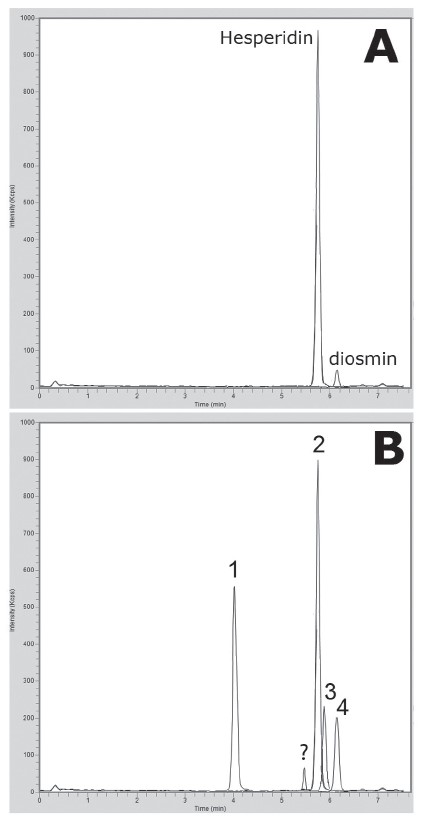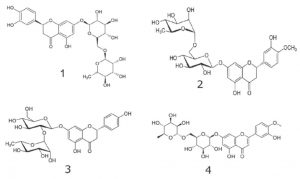Eriocotrin, Hesperidin, Naringin, Diosmin
Click HERE for Column Ordering Information.
In this method, the Hesperidin extract was spiked with three glycosidic flavonoids. The Cogent Phenyl Hydride Column was used to separate the main component of the extract (Hesperidin) and three standards. The MS detection helped to distinguish between the Naringin peak of the standard and a small impurity peak (peak marked “?”). When the Hesperidin extract sample was analyzed, only peaks for Hesperidin and a small peak for Dosmin were detected.


Peaks:
1. Eriocitrin 595.2 [M+H]+
2. Hesperidin 541.2 m/z [M+H]+
3. Naringin 581.2 m/z [M+H]+
4. Diosmin 609.2 m/z [M+H]+
Method Conditions
Column: Cogent Phenyl Hydride, 4µm, 1 00Å
Catalog No.: 69020-05P-2
Dimensions: 2.1 x 50 mm
Mobile Phase:
–A: DI Water / 0.1% Formic Acid (v/v)
–B: Acetonitrile / 0.1% Formic Acid (v/v)
Gradient:
| Time (minutes) | %B |
| 0 | 10 |
| 1 | 10 |
| 9 | 70 |
| 10 | 10 |
Post Time: 3 minutes
Injection vol.: 1µL
Flow rate: 0.4 mL/minute
Detection: ESI – POS – PerkinElmer, Flexar SQ 300 Mass Spectrometer
Samples:
–A: Hesperidin extract (1mg/mL) in DI Water, diluted 1:100 with Solvent B
–B: Hesperidin extract (1mg/mL) in DI Water, diluted 1:100 with Solvent B and spiked with 20 ppm of the
–standards (Eriocitrin, Naringin, Diosmin)
Note: Flavonoids are phenolic substances isolated from a variety of plants and fruits. They are low molecular weight compounds and in plants they are usually bound to sugar molecules as O-glycosides. Flavonoids are present in foods and beverages of plant origin, such as fruits, vegetables, tea, wine etc. They can be divided into fourteen classes, including flavonols, flavones, anthocyanins, isoflavonoids, and flavanones. They have been shown to have anti-inflammatory, anti-allergic, anti-carcinogenic, antihypertensive and anti-arthritic, and free radical scavenging properties.
Attachment
No 293 Spiked Hesperidin Extract pdf 0.3 Mb Download File


